Context
Darkness is a fundamental resource required by biological systems. Artificial light can provide useful functionality to enhance the lives of humans, but the cost of this artificial light is damage to the darkness resource that is foundational to the lives of humans, wildlife, and the ecosystem. Therefore, light pollution must be restricted and regulated.
History
Street lighting has been used for thousands of years.[1] The light assisted in navigation and was presumed to increase safety. Candles and oil lamps were used.
Gas lamps began appearing the late 1700s. Figure 1 shows a person known as a lamplighter lighting the gas light.
Carbon arc lamps were invented and installed in the early 1800s. San Jose, California installed the first “moonlight tower” in 1881. Figure 2 is a drawing of the installation. Arc lamps were described as exceptionally bright and harsh and the light, although useful at industrial sites like dockyards, was discomforting in ordinary city streets.
After Thomas Edison pioneered the Incandescent light bulb, electric lights made their appearance in the late 1800s. The first U.S. city to install electric streetlights was Cleveland, Ohio.[4]
The 1920s saw the introduction of low-pressure sodium, followed by high pressure sodium. The low-pressure sodium lights give a yellow light, while the high-pressure versions are pink to orange. Both types of sodium lights are poor color rendering but are efficient because the light they emit is the type that the human eye is most sensitive to. Figure 3 shows both low- and high-pressure sodium street lights.
Figure 3 – Low[5] and High Pressure Sodium[6]
LED streetlights were installed in the 2010s. LED lights come in different color temperatures, with the most efficient lights having high color temperatures. Therefore, cities that were early adopters installed 5000 Kelvin lights. Due to many complaints about the brightness and harshness of the light, most cities adopted 4000K as their standard. A small number of cities chose 3000K due to concerns about health risks.
Figure 4 – 5000K LED Streetlight[7]
LED streetlights are now available in a wide range of color temperatures, from 1000K to 5000K. Figure 5 shows 1000K bat friendly LED lights in Worcestershire, England.
Figure 5 – Bat Friendly 100K LED streetlight[8]
Discussion
Since streetlights have been used for thousands of years, it makes sense that we have been continuing to install and use streetlights today. However, we need to remember that motor vehicles and their ability to carry their own light has changed things. We need to ask ourselves whether we still need streetlights that light the roadway where vehicles travel since the vehicles already have their own light source.
Many cities and transportation agencies have already switched to LED lights to save energy. However, the high color temperature LED lights (3000K, 4000K, 5000K) create more light pollution than the previous HPS lights because of the large amounts of blue wavelength light which is significantly more powerful than yellow/orange/red light. In addition, many people find the harsh white color objectionable and numerous health studies have shown that LED lights with high blue content can damage both the eyes and human health.
Issues
Light Pollution
Darkness is a critical resource that must be protected for the health, safety, and proper functioning of biological systems. Streetlights are a source of light pollution that must be regulated to minimize its impacts on the dark environment.
One aspect of streetlight pollution is called glare. Human eyes are designed to use reflected light to view objects. A bare-diode streetlight that emits photons, especially high energy blue wavelength photons, directly into the eye causes the photons to bounce around within the retina, causing disabling glare. The result is a loss of image acuity for the scene and damage to the photoreceptors of the eyes.
Another aspect light pollution is contrast, which is the difference between the dark night and the bright streetlights. The greater the difference in contrast, the more effort your eyes go through to adapt to the changing light conditions. This effort results in muscle fatigue in the eye.
Light pollution in the form of high color temperature can be mentally torturous, especially for sensitive receptors. The high energy, blue wavelength light can cause anxiety, anger, agitation, and even thoughts of suicide. High color temperature light also increases disability glare.
Being able to view the stars is a fundamental human right. No rights were granted by any authority to block our view of the stars and since no such rights were granted, the authorities must dictate that our view of the stars be restored. The first step in restoring the stars is removing the streetlights.
Excess light from streetlights contributes to overall light pollution that damages the darkness resource and harms biological systems.
Sensitive Receptors
The emotional component of being hit in the eyes by high energy blue wavelength light cannot be overstated. The eyes are a very sensitive instrument and a person hit in the eyes with such high intensity light will be angry and agitated and may act aggressively. Repeated encounters with these high energy lights can lead to eventual mental collapse due to the similarity to torture.
Sensitive receptors have told us that high color temperature streetlights are mentally disturbing. There is an emotional component of the blue wavelength light that causes sensitive receptors to be come agitated, angry, or depressed. These streetlights disrupt the darkness resource that sensitive receptors are well tuned to.
Safety
There is a widely held assumption that bright lights will keep us safer from crime and help prevent vehicle accidents. However, this assumption is not supported by the research. A 2015 study found no convincing evidence that street lighting reduced either crime or road traffic injuries.[9]
A review published by the U.S. Department of Justice of seven studies undertaken in the 1970s concluded that improved lighting was not an effective means of preventing crime.[10]
Pedestrian fatalities have been increasing in recent years. From 2008 to 2017, the number of pedestrian fatalities increased by 45% during the nighttime, but 11% during the daytime.[11] The number of pedestrian deaths increased in each of the years from 2017 through 2019 corresponds to the same years that high color temperature, high glare LED streetlights were installed. While no studies have been done so far to measure whether these new LED streetlights have increased the risk to pedestrians, it seems likely that brighter, whiter streetlights are not increasing safety and possibly are making the streets more dangerous.
Human Health
High energy, blue wavelength light has been shown to both damage the photoreceptors of the human eye and on circadian rhythms[12]. The switch to LED in streetlights was done without considering the impacts of high color temperatures. The first installations were 5000K, then reduced to 4000K. Local governments are still installing 4000K even though they have known health risks.
Figure 6 shows a street illuminated by 4000K LED streetlights. The first issue is that the glare from the high energy light will reduce driver vision and decrease safety. But the rays from these unshielded streetlights also enter the residences on private property, reducing the ability of residents to get quality sleep.
Figure 6 – 4000K LED Streetlights[13]
Figure 7 shows the light trespass from these same 4000K LED streetlights onto private property. The residents of the property now have harsh white light streaming into their bedroom window all night which results in negative health outcomes.
A recent study found that there is a strong correlation between artificial light at night (ALAN) and emotional disorders, including a correlation between ALAN and an increased risk of developing bipolar disorder.[15] Another study found a correlation between ALAN and increased breast cancer risk.[16]
Ecosystem Health
Nearly all biological systems use the cycle and daylight and darkness to function. One of the main triggers of cellular function is blue wavelength light, which we receive from the sun. The blue wavelengths trigger processes at the cellular level that control eating habits, sleeping and many other functions. Streetlights at night introduce light that damages the darkness resource.
Figure 8 shows burrowing owl habitat being illuminated by streetlights. Studies have shown that burrowing owls stay close to the burrow, so they are unable to escape the lights. The light makes them more visible to predators, and the high glare disrupts their very sensitive vision.
Figure 8 – Burrowing Owls Under Streetlights13
Fireflies need a dark night to communicate and attract mates. The fireflies rely on bioluminescence to find their partners and ALAN interferes with this process. [17] Bright streetlights and light pollution are significant factors in the decline of firefly populations.
Many birds navigate at night by the light of the moon and stars. When we add artificial light from streetlights, we affect the ability of birds to navigate.
Glare
Glare is caused by a significant ratio of luminance between the task (that which is being looked at) and the glare source[18].
Figure 9 shows an example of glare from high color temperature freeway streetlights. The long streaks coming off the lights is the glare in the camera lens, just like the glare in our eyes. This glare causes eye strain and decreases vision. It is also painful and can cause emotional anguish.
Figure 9 – Freeway Streetlight Glare[19]
Color Temperature
Figure 9 shows LED freeway streetlights in the 4000K-5000K range. These high color temperature lights have a large spike of blue wavelength light. This high energy light causes significantly more light pollution than lower energy yellow/orange/red wavelengths of light.
Figure 10 shows 5000K LED streetlights on a residential street in Sunnyvale, CA. Previously, these streetlights were HPS which emitted a soft, soothing glow which was conducive to evening walks and a feeling of safety. When the city replaced the HPS with 5000K LED, the ambience and emotional feeling of the environment changed. Now residents feel like they are living in an “always-on” environment. More than one resident was forced to purchase blackout shades and yet still developed high blood pressure due to the impact of the lights on her sleep.
Figure 10 – 5000K LED Residential Streetlights
A high color temperature LED light has a profound impact on sensitive receptors. Many Highly Sensitive Persons are unable to “tune out” the lights. Instead, the light is a source of distraction and cause of mental anguish. Highly Sensitive Persons tell us that these lights force them to stay indoors due to the emotional disturbance that they cause.
Contrast
According to a review of research literature, ambient lighting on the roadway at night is approximately 1 nit and the people’s eyes should be subject to brightness levels from other sources that do not exceed 10 to 40 times that amount.[20] Streetlights should not over light and they should only provide a a minimum amount of light to assist in navigation. This means that streetlights should not exceed 40 nits at the eye.
Roadways
Streetlights used for lighting the roadway where motor vehicles travel have reached the end of their usefulness. Autonomous and all newer cars use sensors to detect obstacles, use Automated Emergency Braking systems and have headlights. In other words, there is little to no value in lighting the roadway where cars travel.
Roadway illumination has been specified with little consideration of another, ubiquitous source of light on nighttime roads – vehicle headlights.[21] It’s now time to require that the decision as to whether a streetlight is needed for a roadway must consider other sources of lighting that are available, specifically, vehicle headlights, and must take into account the health risks of light pollution and the damage to the darkness resource.
In addition, the automotive industry has developed detection systems that can see a vehicle’s environment better than human eyesight. These systems are already in deployment and being used within the vehicle’s Automatic Emergency Braking systems.[22] If we refer back to Figure 9, we can ask, “What is the function of these streetlights?”. The glare is making driving more difficult, cars already have headlights, this is not a pedestrian area, soon all vehicles will have AEB systems, and the lights are polluting our darkness resource.
Energy Use
Figure 11 shows streetlights using energy but serving no purpose and causing light pollution.
Figure 11 – Streetlights over empty streets
There are over 1,000,000 streetlights in the state of California.[23] Even if all the streetlights are LED and use only 30 watts, this is still 30,000,000 watts (30 Megawatts) of energy. If we consider Figure 11 we may realize that most of this energy being used to power streetlights is wasted by serving no purpose, while simultaneously damaging our darkness resource.
Streetlights
Many cities have installed 4000K and 5000K color temperature lights with high intensity. These lights are painful to the eyes and interrupt sleep. These lights are destroying the ability of insects, birds and even plants to function at night. Light pollution is increasing around the world at a rate of 2% per year.
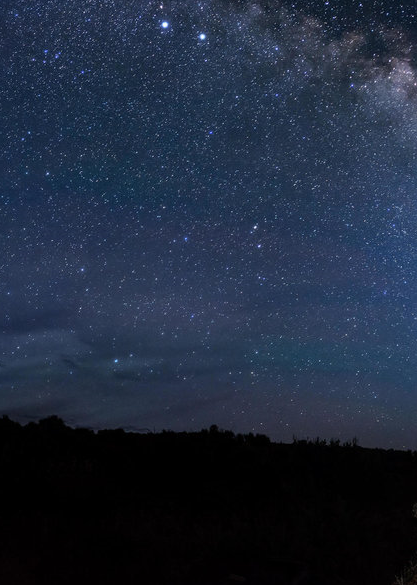
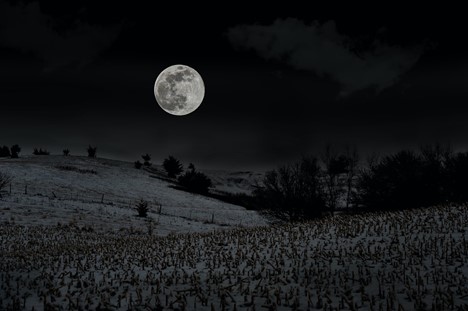
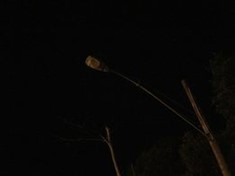
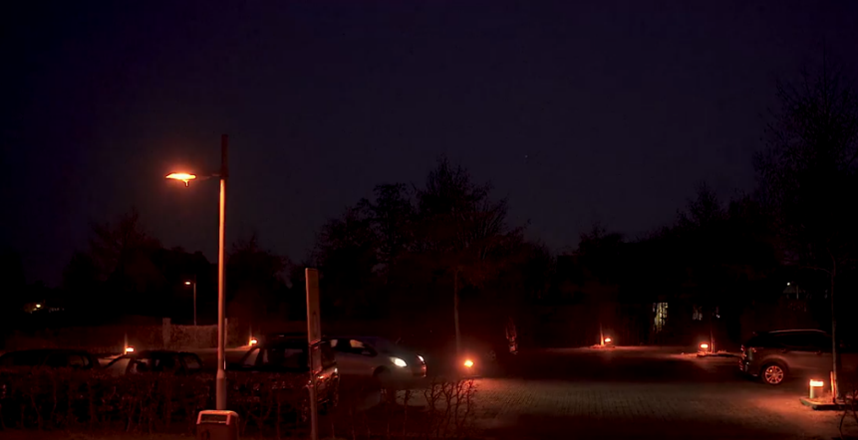
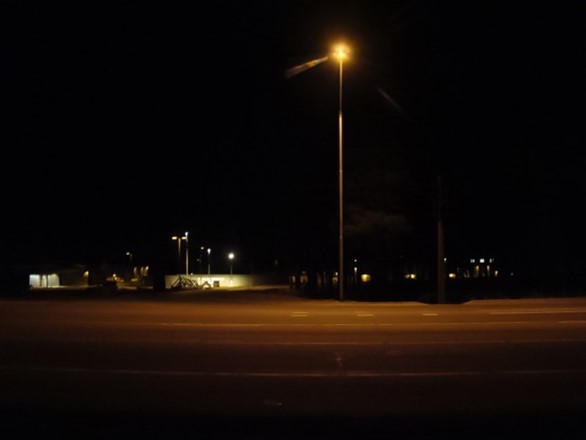
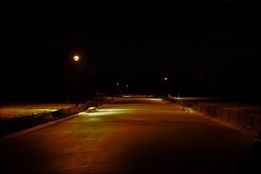
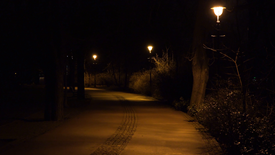
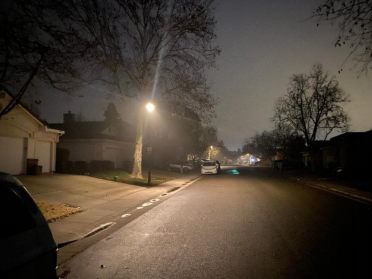
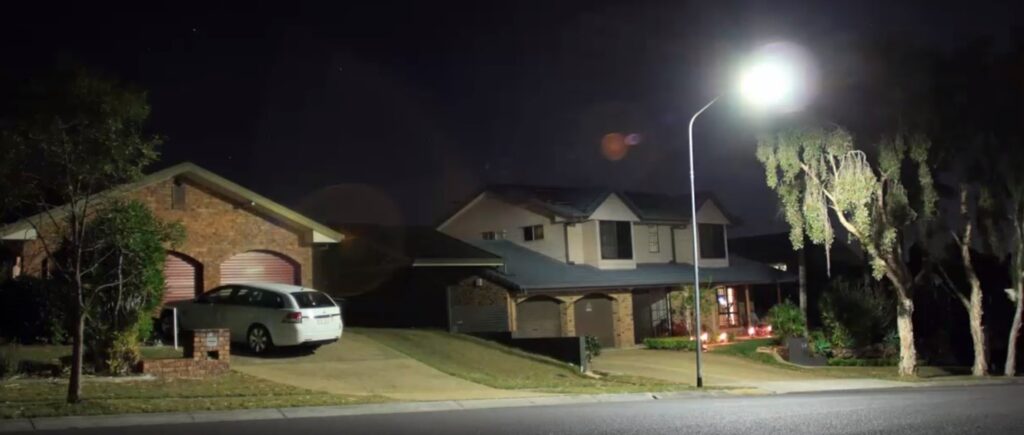
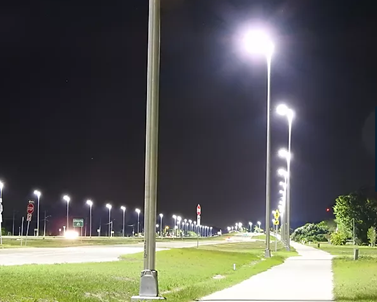
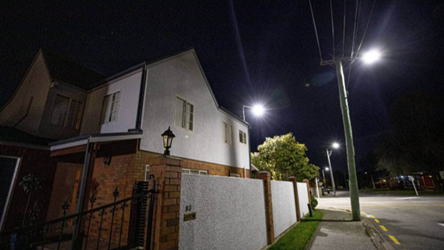
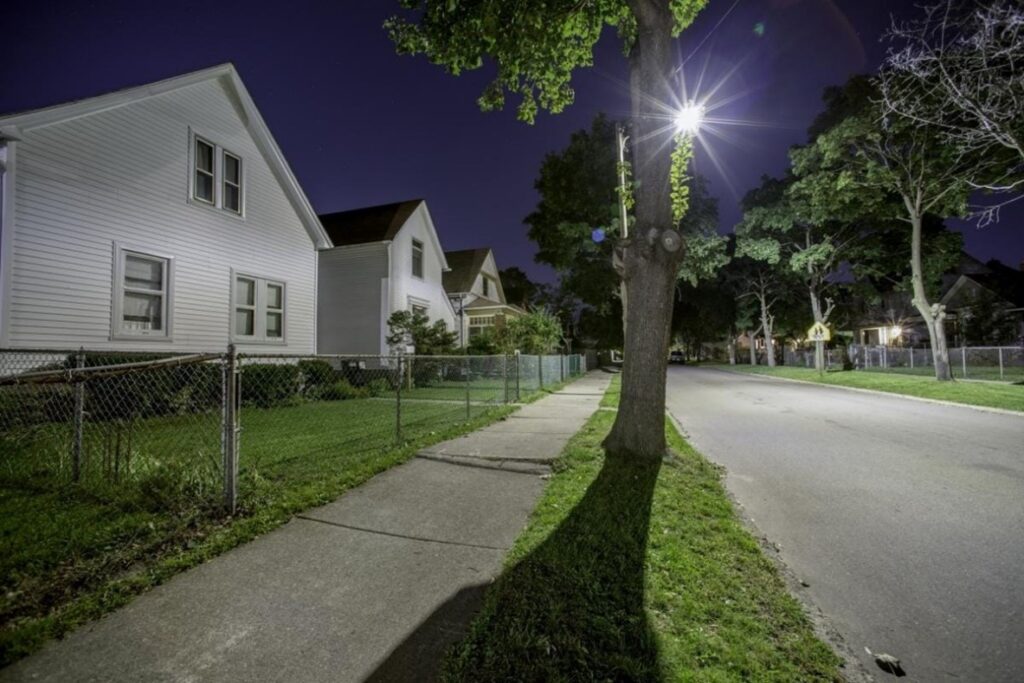
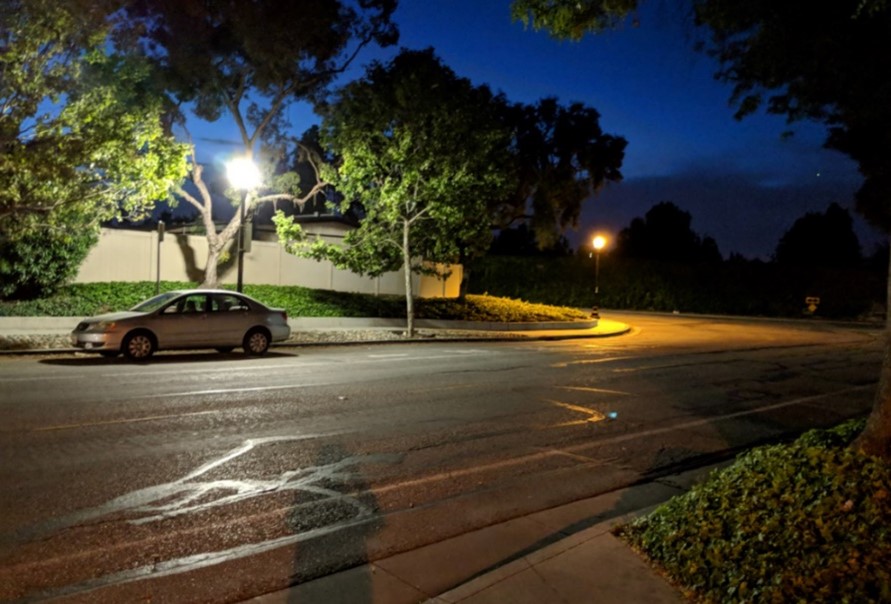
Proposed Regulations
Darkness is a fundamental resource that is needed for the proper functioning of biological systems. Anthropogenic artificial light damages the darkness resource and therefore must be limited and regulated. We propose that streetlights be regulated as light pollution.
The original purpose of street lighting was to assist pedestrians with navigation at night and to assist motor vehicles in their first few years of existence. Now that motor vehicle headlights have evolved into such powerful sources of light and now that vehicles can keep us safe through sensors and the AEB system, it is time to retire roadway streetlights.
We propose the following regulations:
- Set a maximum color temperature of 2700K and a minimum Spectral G-Index of 1.56 for all streetlights. Set a maximum color temperature of 2200K for all residential streetlights.
- Prohibit the installation of new roadway overhead streetlights.
- Use bollards, ground-mounted or similar luminaires to light pedestrian and bicycle paths instead of using overhead lighting. Restrict the spacing between lights so that they are not close together. The human eye is very sensitive and does not need much external light.
- Require that all streetlights, bollards, and other outdoor lighting have shielding and diffusion with a BUG rating of (B0, U0, G0).
- Luminance maximum of 40 nits at eye level.
- Use sensors to restrict pedestrian and bike path lighting to turn on only as necessary.
- Set a timeline for the orderly removal of existing overhead streetlights.
Additional References
- “an association between dimming and reductions in crime, particularly for violent crime.” – Journal of Epidemiology and Community Health (2015) – The effect of reduced street lighting on crime and road traffic injuries at night in England and Wales: a controlled interrupted time series analysis
- ”evidence is mounting that nighttime brightness may do little to stop crime, and in some cases may make it worse.” – Washington Post (2017) – What actually happens to crime ‘when the lights are on,’ as Rick Perry suggests
- ”It may make us feel safer, but has not been shown to make us safer” – International Dark Sky Association (2020) – Lighting, Crime and Safety
- https://digitalcommons.iwu.edu/psych_honproj/180/
- https://www.darksky.org/the-psychology-of-dark-skies/
[1] https://en.wikipedia.org/wiki/Street_light
[2] https://cbrowder.blogspot.com/2013/12/103-lighting-city-pushing-back-night.html
[3] https://www.lowtechmagazine.com/2009/01/moonlight-towers-light-pollution-in-the-1800s.html
[4] https://en.wikipedia.org/wiki/History_of_street_lighting_in_the_United_States
[5] https://www.murrietaca.gov/244/The-Basics-of-LED-Lighting
[6] https://www.stcatharines.ca/en/livein/LED-Streetlight-Upgrade-Project.asp
[7] Soft Lights
[8] https://www.bbc.com/news/uk-england-hereford-worcester-49534621
[9] https://www.ncbi.nlm.nih.gov/books/NBK316511/
[10] https://cops.usdoj.gov/RIC/Publications/cops-p156-pub.pdf
[11] https://www.ghsa.org/sites/default/files/2019-02/FINAL_Pedestrians19.pdf
[12] https://www.ncbi.nlm.nih.gov/pmc/articles/PMC4734149/
[13] https://www.bslighting.org/light-pollution
[14] https://www.bslighting.org/light-trespass
[15] https://jamanetwork.com/journals/jamapsychiatry/fullarticle/2767698
[16] https://ehp.niehs.nih.gov/doi/10.1289/ehp935
[17] https://www.sciencedaily.com/releases/2020/02/200204094744.htm
[18] https://en.wikipedia.org/wiki/Glare_(vision)
[19] https://www.menshealth.com/health/a19524460/led-streetlights-create-driving-risk/
[20] http://www.illinoislighting.org/resources/DigitalBillboardLuminanceRecommendation_ver7.pdf
[21] https://journals.sagepub.com/doi/10.1177/1477153517730723
[22] https://blogs.nvidia.com/blog/2019/04/15/how-does-a-self-driving-car-see/
[23] https://cltc.ucdavis.edu/streetlighting-market-assessment-survey